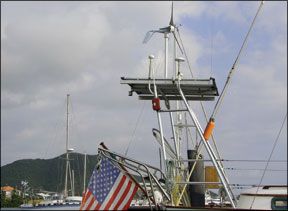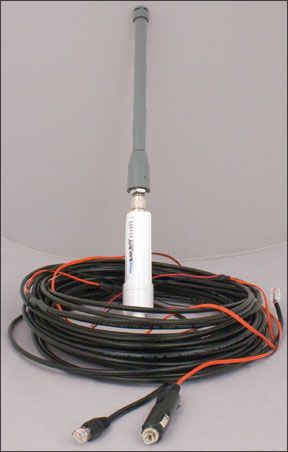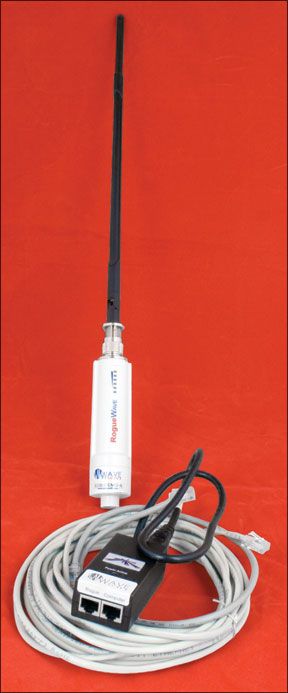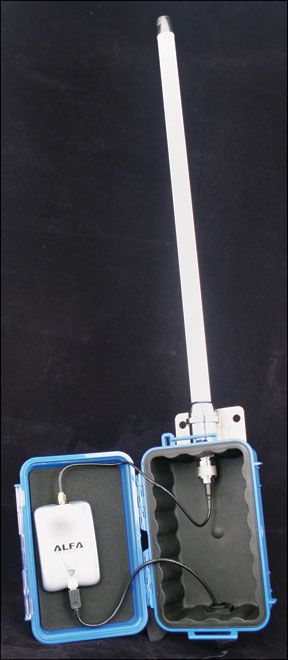It used to be that when cruising boats packed into a corner of an anchorage, it was for better holding ground. Today, the favored corners are often prized for whats ashore nearby: a Wi-Fi hotspot.
In January 2009, Practical Sailor looked at ways to maximize the range of 2.4-gHz wireless connections to Internet access points. One product reviewed for that report, the 5mileWiFi ($400), lived up to most of our expectations. It solidly connected to a hotspot atop a hotel more than 4 miles away. Even so, testers concluded that expecting a five-mile Wi-Fi connection everywhere you go is too optimistic, particularly given the amount of radiated noise and signal interference in a typical anchorage or marina.

Photo (top) courtesy of The Wirie
Since that test, the Wi-Fi landscape has shifted rapidly, with several new products entering the market. So, with the help of suggestions from our readers, we began a search for alternatives to the 5MileWiFi, focusing on products geared toward the marine market. The most common units aimed at cruising sailors perform two functions: They increase the transmitted power, and they boost the received signal. Performance claims for these products usually tout the “boosted” output power or EIRP (Effective Isotropic Radiated Power). However, simply looking at total output of a Wi-Fi signal doesn’t present a full picture. (See “Ideal Performance Balances Gain and Environment,” page 30.)
Most marine Wi-Fi products meet or nearly meet the Federal Communications Commissions (FCC) 1-watt limit for transmitter power output, and many different brands share the same basic hardware. For this reason, other factors such as ease of installation, user interface, accessories, price, warranty, and product support can carry more weight. How you plan to use the device also matters. Some antenna are better adapted for permanent outdoor installations, far from the main computer, while others are more portable.
What We Tested
To contain the scope of the project, Practical Sailor focused on three products suggested by readers: the Bad Boy Xtreme from Bitstorm, the Rogue Wave from GeoSat Solutions, and The Wirie, developed by cruising couple Mark Kilty and Liesbet Collaert. All three products are marketed specifically to boaters, and they represent the two principal types of devices that users will find: USB-type units that plug into computer or laptop USB ports and Power over Ethernet (PoE) “bridges” that network via your computers Ethernet port to provide a pathway to the Internet
The Bad Boy Xtreme is a 1,000-mW Ethernet bridge developed by Toronto-based Bitstorm. The company currently markets three products: the Bad Boy Xtreme for long-range reception, the more portable Bad Boy Express, and the Bad Boy Unleashed for setting up an onboard wireless network.
The Rogue Wave is one of several devices from Wave Wi-Fi, a subsidiary of GeoSat Solutions. Based in Hollywood, Fla., Wave specializes in wireless communication for yachts, marinas, and commercial ships. The third product we tested, The Wirie, was designed by cruising sailors. The unit is essentially an external Wi-Fi adapter designed for home use that has been converted for the marine market by putting it in an insulated, watertight box and connecting it to a marine-grade antenna.
The selection is by no means exhaustive, and we welcome readers comments on devices they have used. Some Practical Sailor testers have achieved good results with non-marine exterior antennas (the 11-dBi puck-type, for example), but for cruisers who spend a lot of time on the move, getting a marine-oriented system with 6- to 9-dBi antenna will ensure longer service life and better connectivity in more places.
How We Tested
All three units were installed and connected to a three-year-old laptop running Windows XP (Service Pack 2). Connectivity was evaluated multiple times at two locations around Sarasota, Fla. The primary location for testing was the anchorage at the Sarasota Sailing Squadron, approximately 2 miles across the water from several hotspots in downtown Sarasota. Additional testing was carried out from our third-floor office on the coast of south Sarasota.

Some degree of subjectivity was inevitable as the devices were rated for installation difficulty, quality of instructions, and ease of use. Hardware components were inspected for potential failure points, and any water-resistance claims were tested.
Although two devices, the Bad Boy Xtreme and the Rogue Wave, tended to pick up more hotspots than The Wirie, when testers tried to actually connect to the weaker signals, connectivity was unreliable. In practice, no single device stood out for its range or superior connectivity at either location. The chief differences were in the ease of installation, user interface, and durability.
Bitstorm Bad Boy Xtreme
The Bitstorm Bad Boy Xtreme presented an interesting challenge. Could we add one more trendy moniker to this product without offending sensibilities? “The Mega Bad Boy Xtreme Ultimate?” (Itll come to us.)
In juxtaposition to its name, the Xtreme hardware stood out for its utilitarian approach. According to the maker, the product evolved from the companys experience installing hotspots for various marinas. The heart of the unit is the 6-inch-long Bullet2HP from Ubiquit (www.ubnt.com), a powered Ethernet bridge with a built-in 180-MHz processor, 16-MB SDRAM, and 4-MB flash memory. Output is rated at 1,000 mW. Because the Bullet2HP is effectively a standalone processor directly attached to an antenna, it can be located as far as 300 feet away from the laptop without any loss of performance.
The Bullet2HP has a standard RJ45 Ethernet plug on the bottom protected by a split rubber seal that fits around the Cat-5 Ethernet cable. The common N-type coaxial connector on the top is adaptable to a wide range of antennas. The Bullet2HP is designed for outdoor use, but it is not designed for immersion. To extend service life, owners will want to seal RJ45 connector connectors with dielectric grease, which Bitstorm thoughtfully provides. These are not marine-grade connectors, in our view. Maximum power consumption is listed at about 7 watts, or 0.6 amps in a 12-volt system. Typical power consumption is 300-400mA at 12 volts. The Bullet2HP can also be purchased alone from dealers for about $80.
The standard Xtreme kit ($170) comes with a rugged, 18-inch battleship-grey, 6-dB omnidirectional antenna. An exterior-grade black, Cat-5 Ethernet cable is extra. Much stiffer than conventional Cat-5 wire, this polyethylene coated wire will hold up better to ultraviolet rays.
While both The Wirie and Wave opt for 8- to 9-dBi antennas in their standard kits, the Bitstorm engineers believe 6-dBi to be the best compromise when dealing with the variety of conditions in a typical harbor, particularly when there are other boats nearby. The antenna functioned very well in field tests.
A 12-volt installation requires leading the power wires to the breaker panel. This is a pain with tiny Cat5 cable wires, but a junction box is provided. Once powered up, you plug in the Ethernet cable, type the supplied URL into your browser, and log in. No software or drivers are needed. The Bad Boy can also be set up to automatically connect to the strongest unsecured access point.
An optional 100-240 VAC power injector costs extra. The main difference between this product and the Rogue Wave is the software. The Rogue Waves interface was simpler, but the Xtremes default interface was fine. (There is an advanced setting, as well.)

Bottom line: This product was quick to install and performed well in the field. If you are looking for a solid, compact masthead or rail mount at an affordable price, this is a good choice.
Wave Wi-Fi Rogue Wave
The Rogue Wave is one of a several high-tech communication devices from Wave Wi-Fi that cater to yachts, marinas, and commercial boats.
The Rogue Wave is based around the same Bullet2HP device that anchors the Xtreme Bad Boy. The standard Rogue package, which retails for $400, comes with 25 feet of interior grade, Cat-5 cable, a folding “duck” antenna, a 110-volt (converting to 12-volt) plug-in power injector, and a short length of Cat-5 cable to go from the injector to the laptop. A users guide on disc is also provided. A direct 12-volt power kit is optional.
Despite the hardware similarities with the Bad Boy Xtreme, we noted several key differences. The standard folding duck antenna is a lower profile unit with a hinge that makes it adaptable to vertical mounting. It fared well in testing, but it is not as rugged as the other antennas in the test. For a permanent installation, wed consider the optional fiberglass 8-dB antenna.
Having been in the recreational and commercial marine Wi-Fi business for several years, the company has a good idea of what works at sea and what doesn’t. Testers noted that the company provides explicit warnings that prolonged marine exposure of its unit will shorten the life of the internal circuitry.
Installation was fairly straightforward, although testers had trouble seating the RJ45 plugs in the power injector. The biggest difference between the Rogue Wave and the Xtreme was the software. The Rogue Waves interface was much cleaner, clearly indicating the most powerful hotspots nearby and making it easier to setup an onboard network with multiple computers.
Bottom line: This unit was pricey compared to the similar Bad Boy Xtreme, but the interface is a step up and the company has a wider dealer network.
The Wirie (no longer available)
The origin of The Wirie is typical of many innovative marine products: A cruising sailor combines his or her professional background with sailing experience to come up with a solution to a vexing problem.
While cruising in the Caribbean aboard their 35-foot Fontaine Pajot catamaran, Kilty and Collaert came up with the idea for a rugged Wi-Fi booster that could be made using existing off-the-shelf components. The Wirie eliminates the signal loss of a long coax run by taking an Alfa Network 1,000-mW USB wireless adapter (AWUS036H) and putting it in a watertight box. A short length of coaxial cable joins the adapter to an 8.5-dB antenna. The kit, including a stainless-steel mounting bracket and 15 feet of USB cable costs $250.

Because the USB adapter operates like a familiar internal Wi-Fi card, some might find this product to be a more user-friendly solution than Ethernet bridge setups. It can also be networked (with some effort) with other onboard computers using the computers Internet Connection Sharing feature. Unlike the 5MileWiFi we tested last year, The Wirie does not require a separate USB connection for power. All the required power comes through the single USB, liberating the user from a power cord.
While the unit performed as advertised, Practical Sailor noted three principal drawbacks to using a USB device rather than one of the PoE devices. Because of limitations imposed by USB standards, youll need an Active USB extension cable for every additional 15 feet of cable. This means that if more than 15 feet of the required cable run is above decks, youll have a vulnerable USB union exposed to weather. PoE cable runs can be as long as 300 continuous feet.
Another drawback-for those of us without a teenager handy-is that this unit requires installing new software and drivers. Conflicts with the internal card on our laptop set us back more than an hour. Testers also had a hard time finding a tech support number to call, but The Wirie has since added one to its website and now prominently displays a number to call inside the door of each unit. Finally, The Wirie is less streamlined than the Bullet2HP-based units.
In spite of the installation challenge, Practical Sailor liked The Wirie for a few reasons. Even though the Wi-Fi adapter is designed for interior use, the box will better stand up to a beating than the Bullet2HP. We submersed the box for 30 minutes in 3 feet of water, and it remained bone dry. We wouldnt dare try that with the Bullet2HP.
The other advantage of The Wirie is that once you buy the box, you can continually upgrade the hardware, or replace it at a modest cost. The Alfa sells separately for about $40 online.
Once installed, The Wirie performed as advertised. The software interface was easy and familiar, clearly identifying the strongest hotspots in the neighborhood, both on the water and ashore.
The Wiries chief advantage is its portability. You can easily remove the Alfa from the box, screw on its original 5 dBi antenna and bring it ashore.
Bottom line: Once you get through the installation, The Wirie is a simple and practical solution to getting better Wi-Fi reception on board-just what you’d expect from cruising sailors. Unfortunately it did not have the endurance in a competitive market. If you have one of these on board, you might be able to salvage some parts.
Conclusion
Picking a winner out of this crowd was tough as there were no clear performance advantages and each had features that might appeal more to individual sailors. Nevertheless, after weighing all the options and spending time with these units, we came up with some clear recommendations.
In terms of getting the essentials at a rock-bottom price, it is hard to beat the Bitstorm Bad Boy Xtreme. True, its software interface is not as clean as the Wave Wi-Fi, but we were able to install the unit and log on to a nearby hotspot in a matter of minutes. For power source, the cigarette-lighter plug works for the short term, but someone seeking a more permanent installation will want to wire the unit using the junction box.
The Rogue Wave is clearly the work of an established company with experience in the finicky recreational market. If you want good tech support and are concerned about having someone back the product for years from now, consider the Rogue Wave.
The simplicity of The Wirie grew on us, but wed like to see a longer warranty. For the outdoor enthusiast with boats and RVs who wants a rugged, portable antenna, The Wirie works great. As a bonus, the unit can be affordably upgraded or replaced as technology progresses. And it will … quickly.



































